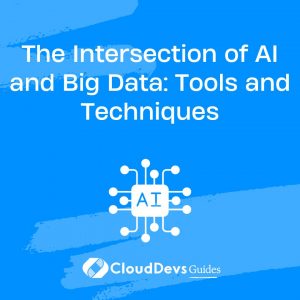The Intersection of AI and Big Data: Tools and Techniques
In the modern digital landscape, two revolutionary technologies have emerged as the driving forces behind innovation and transformation: Artificial Intelligence (AI) and Big Data. Individually, these technologies have already made significant strides, reshaping industries and enabling new possibilities. However, it’s at the intersection of AI and Big Data that their true potential is unlocked. This synergy holds the promise of uncovering hidden insights, making informed decisions, and fueling unprecedented growth across various sectors.
1. Understanding AI and Big Data
1.1 AI: Pioneering Intelligent Automation
Artificial Intelligence refers to the simulation of human intelligence in machines, enabling them to mimic human-like tasks such as problem-solving, decision-making, language understanding, and more. Machine Learning (ML), a subset of AI, empowers systems to learn from data and improve their performance over time. Deep Learning, a more advanced form of ML, utilizes neural networks to process vast amounts of data and extract intricate patterns.
1.2 Big Data: Unveiling Insights in Vastness
Big Data involves the collection, storage, and processing of massive volumes of data that traditional data management tools struggle to handle. This data can be structured, semi-structured, or unstructured, and it’s generated from various sources like social media, IoT devices, sensors, and more. The challenge lies in extracting meaningful insights from this ocean of information to support decision-making and innovation.
2. The Synergy Unleashed
2.1 Enhanced Data Analysis with AI
The marriage of AI and Big Data creates an environment where data analysis is more accurate, efficient, and insightful. AI algorithms can sift through vast datasets at incredible speeds, recognizing complex patterns that human analysts might overlook. For instance, AI-powered image recognition can identify objects within images or videos, enabling applications ranging from healthcare diagnostics to autonomous vehicles.
Code Sample 1: Image Classification with Convolutional Neural Networks (CNNs)
python
import tensorflow as tf
from tensorflow.keras.layers import Conv2D, MaxPooling2D, Flatten, Dense
# Build a CNN model
model = tf.keras.Sequential([
Conv2D(32, (3, 3), activation='relu', input_shape=(128, 128, 3)),
MaxPooling2D(2, 2),
Conv2D(64, (3, 3), activation='relu'),
MaxPooling2D(2, 2),
Flatten(),
Dense(128, activation='relu'),
Dense(10, activation='softmax')
])
# Compile and train the model
model.compile(optimizer='adam', loss='categorical_crossentropy', metrics=['accuracy'])
model.fit(train_data, train_labels, epochs=10)
2.2 Predictive Analytics and Decision Making
AI-driven predictive analytics benefit significantly from Big Data. By analyzing historical data and recognizing trends, businesses can make accurate predictions about future outcomes. This aids in informed decision-making, risk assessment, and resource allocation. For example, in financial services, AI algorithms can analyze market trends and customer behaviors to optimize investment strategies.
Code Sample 2: Time Series Forecasting with LSTM
python
import numpy as np
from tensorflow.keras.models import Sequential
from tensorflow.keras.layers import LSTM, Dense
# Prepare time series data
time_series_data = # Load or generate your time series data
X = time_series_data[:-1]
y = time_series_data[1:]
# Build an LSTM model
model = Sequential([
LSTM(64, activation='relu', input_shape=(sequence_length, num_features)),
Dense(1)
])
# Compile and train the model
model.compile(optimizer='adam', loss='mean_squared_error')
model.fit(X, y, epochs=10)
2.3 Personalized Experiences and Recommendations
One of the remarkable intersections of AI and Big Data lies in personalized experiences and recommendations. AI algorithms analyze user behaviors and preferences by processing massive amounts of data, enabling platforms to provide tailored content, products, and services. This level of personalization enhances user engagement and satisfaction. Companies like Amazon and Netflix leverage this to offer personalized product recommendations and content suggestions.
3. Tools and Techniques for the Synergy
3.1 Data Collection and Storage
Handling Big Data requires robust data collection and storage mechanisms. Technologies like Apache Hadoop and Apache Spark provide scalable frameworks for distributed data processing. They enable businesses to process, analyze, and derive insights from vast datasets efficiently.
3.2 Machine Learning Libraries
Several open-source libraries facilitate the application of AI algorithms to Big Data. TensorFlow and PyTorch offer powerful tools for building and training machine learning models. Their distributed computing capabilities enable efficient processing of massive datasets.
Code Sample 3: Distributed TensorFlow with Keras API
python
import tensorflow as tf
from tensorflow.keras.layers import Dense
from tensorflow.keras.models import Sequential
from tensorflow.keras.optimizers import Adam
# Build a distributed model
strategy = tf.distribute.MirroredStrategy()
with strategy.scope():
model = Sequential([
Dense(64, activation='relu', input_shape=(input_dim,)),
Dense(128, activation='relu'),
Dense(output_dim, activation='softmax')
])
model.compile(optimizer=Adam(), loss='categorical_crossentropy', metrics=['accuracy'])
# Train the model with large-scale data
model.fit(train_dataset, epochs=10)
3.3 Cloud Services
Cloud platforms like AWS, Google Cloud, and Azure offer AI and Big Data services. These platforms provide scalable infrastructure, pre-built AI models, and tools for data analysis and visualization. They eliminate the need for heavy upfront investments in hardware and software.
3.4 Data Preprocessing and Feature Engineering
Before feeding data into AI models, preprocessing and feature engineering are crucial. Libraries like scikit-learn assist in tasks such as data cleaning, normalization, and feature extraction. This ensures that the data is in optimal form for training.
3.5 Challenges and Future Directions
While the intersection of AI and Big Data holds immense potential, it also presents challenges. Data privacy, security, and ethical concerns are paramount, as handling large volumes of data increases the risk of breaches. Additionally, ensuring the quality and reliability of data is crucial for accurate AI predictions.
Looking ahead, the synergy between AI and Big Data is expected to drive further innovation. As AI algorithms become more sophisticated, they will extract even deeper insights from complex datasets. Improved hardware, like Graphics Processing Units (GPUs) and specialized AI chips, will enable faster and more efficient processing.
Conclusion
The fusion of Artificial Intelligence and Big Data is reshaping industries and revolutionizing the way we approach data analysis and decision-making. By leveraging the power of AI to process and derive insights from massive datasets, businesses can gain a competitive edge, drive innovation, and enhance customer experiences. From personalized recommendations to predictive analytics, the possibilities are boundless at the intersection of AI and Big Data. As technology continues to evolve, embracing this synergy will be a strategic imperative for organizations aiming to thrive in the data-driven era.
Table of Contents









